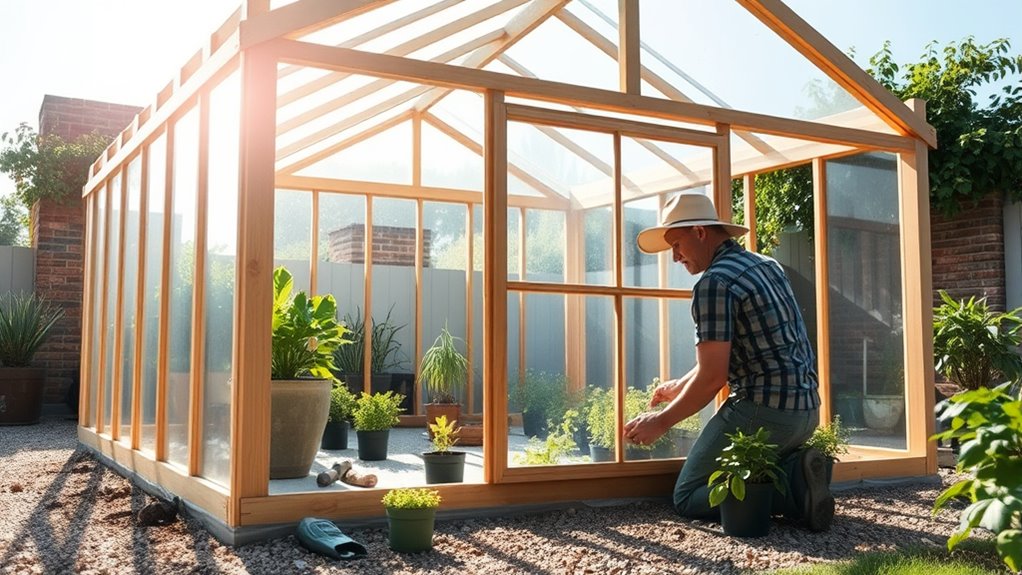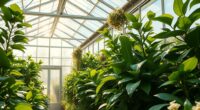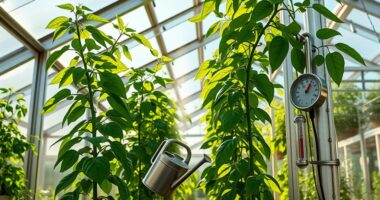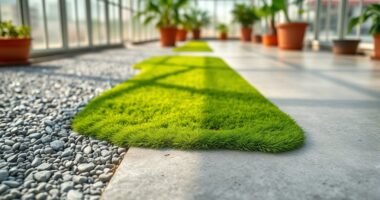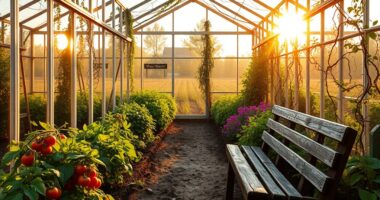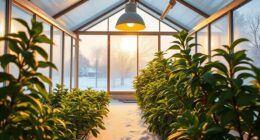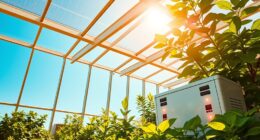To start your greenhouse journey, choose a well-drained, sunny location away from low-lying flood zones and shaded areas. Design a size that fits your space and future needs, considering ventilation and plant access. Select durable materials like polycarbonate panels and reliable irrigation systems such as drip or sprinkler setups. Plan for proper climate control with ventilation, heating, and cooling options. Keep these essentials in mind, and you’ll be ready to create a thriving greenhouse environment.
Key Takeaways
- Choose a well-drained, sunny site with good airflow, avoiding low-lying or shaded areas.
- Determine the appropriate greenhouse size and design for current and future needs.
- Select durable materials and essential equipment like ventilation, heating, and irrigation systems.
- Test soil pH and amend as needed to ensure healthy plant growth.
- Plan for proper ventilation, climate control, and watering systems to maintain optimal conditions year-round.
Selecting the Ideal Location for Your Greenhouse
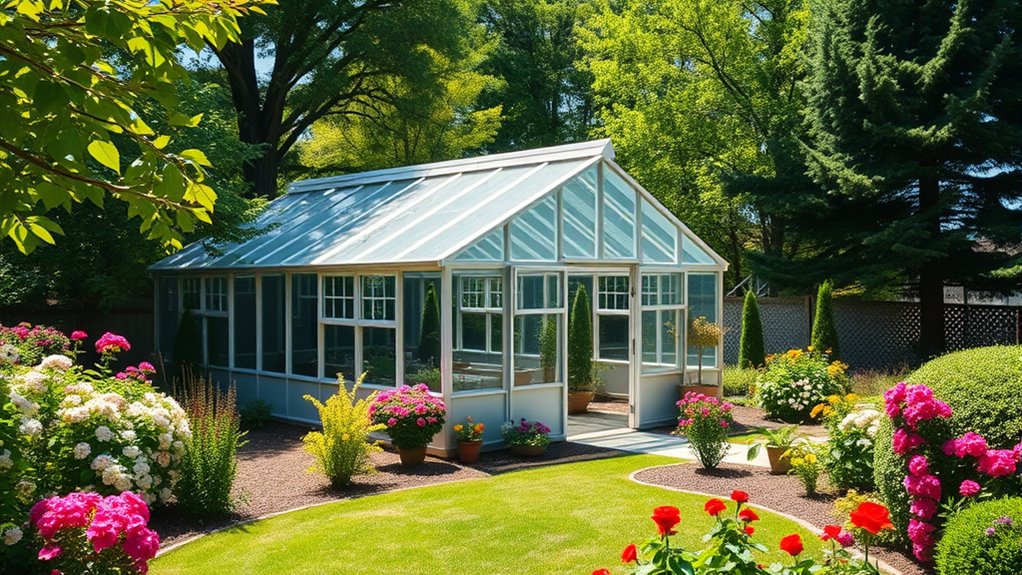
Choosing the right location is crucial for your greenhouse’s success. You want a spot with well-drained soil that’s easy to prepare, guaranteeing your plants get the best start. Before setting up, focus on soil preparation—test the soil’s pH and add amendments if needed to promote healthy growth. Picking a site with good airflow helps with pest control by reducing humidity and discouraging pests and diseases. Avoid low-lying areas prone to flooding or areas shaded by tall trees, which can limit sunlight. Consider proximity to your home for convenience, but also ensure the location receives ample sunlight during the day. Proper site selection and soil prep create a solid foundation for your greenhouse, reducing future pest problems and boosting plant health. Additionally, selecting a location with proper drainage and soil quality can significantly improve your greenhouse’s overall success and longevity. Ensuring the site has appropriate ventilation and sunlight exposure is also essential for plant vitality and preventing issues like mold and pests. Paying attention to microclimates around your site can further optimize growing conditions and protect your plants from extreme weather. Being aware of potential wind exposure can help you plan for protective measures, ensuring your greenhouse remains stable and your plants thrive. Incorporating proper ventilation systems can further enhance airflow and maintain healthy growing conditions inside your greenhouse.
Determining the Right Size and Design

Once you’ve identified the ideal location and prepared the soil, the next step is to determine the right size and design for your greenhouse. Consider your plant layout to optimize space and ensure easy access for watering, pruning, and harvesting. Think about the types of plants you want to grow and how much space they’ll need. A larger greenhouse offers more flexibility but requires more maintenance and resources. Also, plan for pest management by designing ventilation and airflow systems that reduce humidity and discourage pests. Keep in mind that a well-thought-out design minimizes future problems, making your greenhouse more efficient and enjoyable. When planning your structure, consider greenhouse size and how it can accommodate your growing needs over time. Additionally, evaluating ventilation and airflow systems during the design phase can greatly enhance plant health and reduce pest issues. Incorporating proper insulation can help maintain consistent temperatures and protect your plants from extreme weather conditions. Selecting the right watering tools, such as self-watering or waterless planters, can further streamline maintenance and support healthy growth. Being mindful of environmental control strategies can help create an optimal growing environment year-round. Balancing size with your goals will set a solid foundation for a successful greenhouse journey.
Choosing the Appropriate Materials and Equipment

Selecting the right materials and equipment is crucial to building a durable, efficient greenhouse that meets your needs. You want sturdy, weather-resistant framing and glazing that optimize sunlight. For soil preparation, choose quality soil amendments and consider raised beds to improve drainage and prevent pests. Equipment like pest control tools—traps, barriers, and organic sprays—are essential for maintaining healthy plants. Here’s a quick overview:
| Material/Equipment | Purpose |
|---|---|
| Polycarbonate panels | Durable, insulating glazing |
| Ventilation fans | Regulate temperature and airflow |
| Pest control supplies | Keep pests at bay and protect plants |
Choosing appropriate materials ensures longevity and helps create an ideal environment for your plants to thrive.
Planning for Ventilation, Heating, and Cooling
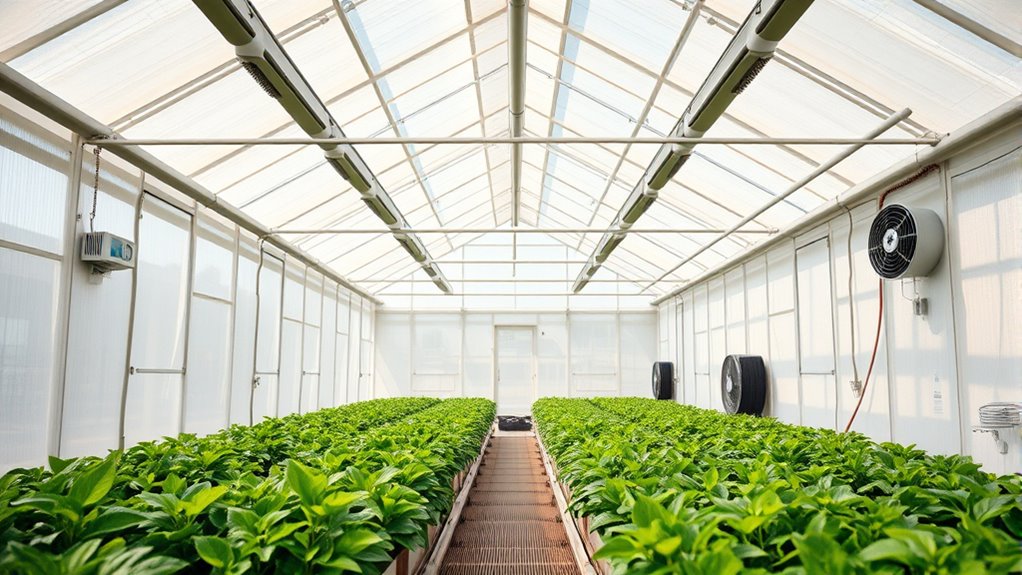
Effective ventilation, heating, and cooling are essential to maintaining a stable environment inside your greenhouse. You should start by evaluating your ventilation strategies to ensure sufficient airflow, which prevents overheating and reduces humidity. Using expert voice actors in promotional content can help communicate the importance of proper climate control to your audience. Installing proper climate control equipment, such as exhaust fans, vents, and circulation fans, helps regulate temperature and humidity levels. Consider natural ventilation options like roof vents and sidewall openings for energy efficiency. For heating, choose reliable systems like heaters or heat mats that can maintain consistent temperatures during colder months. Cooling options include shade cloths, evaporative coolers, or exhaust fans to prevent overheating during warmer weather. Proper planning for these systems now will create a comfortable environment that supports healthy plant growth year-round. Additionally, understanding climate control principles can optimize your greenhouse conditions and improve plant health. Incorporating environmental monitoring tools can further enhance your ability to maintain ideal conditions and respond promptly to any changes. Implementing these strategies ensures a stable environment that promotes vigorous plant growth and higher yields. Moreover, selecting appropriate ventilation methods based on your specific climate can further enhance air circulation and temperature regulation.
Setting Up Watering and Irrigation Systems
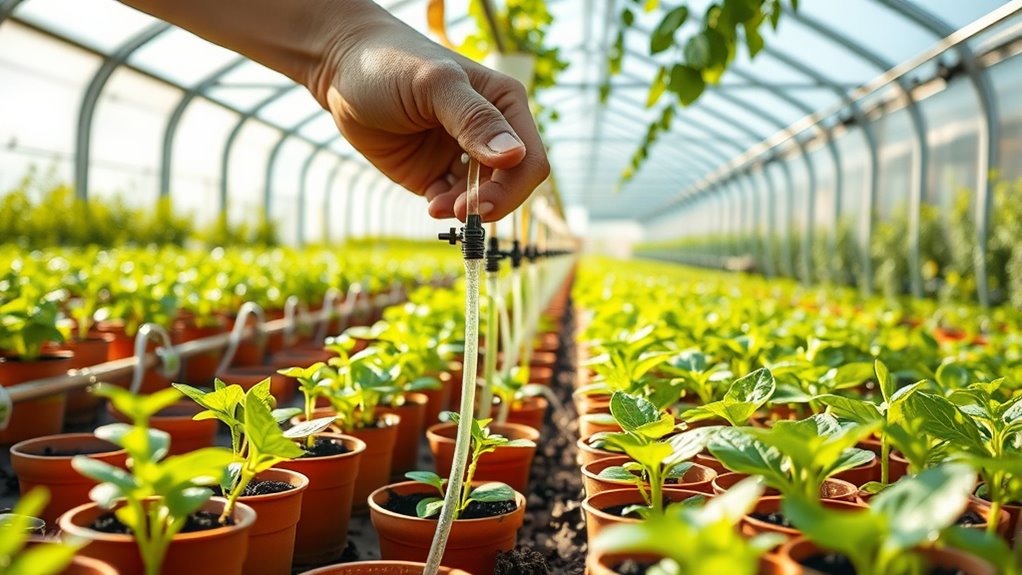
Setting up a reliable watering and irrigation system is essential for maintaining healthy plants in your greenhouse. Proper systems guarantee consistent moisture, prevent overwatering, and save you time. Consider these options: 1. Use drip irrigation for precise watering directly at the plant roots, reducing waste and disease risk. 2. Install sprinkler systems for larger areas, providing even coverage and easy control. 3. Combine both systems to tailor watering schedules based on plant needs and climate conditions. Ensure your system has adjustable timers and pressure regulators for efficiency. Regularly check for clogs or leaks to keep everything running smoothly. Incorporating proper installation techniques can enhance system efficiency and longevity. Additionally, selecting the right components and materials suited for greenhouse environments can further improve performance. Considering climate control options can also help optimize watering schedules and plant health. Utilizing advanced irrigation technology can further improve water efficiency and system responsiveness. With the right setup, you’ll promote healthy growth and simplify your greenhouse maintenance. Proper irrigation is key to thriving plants and a successful greenhouse journey.
Frequently Asked Questions
What Permits or Regulations Are Needed to Build a Greenhouse?
When building a greenhouse, you need to check local regulations first. You’ll want to review greenhouse zoning rules to guarantee your project complies with land use policies.
Additionally, you must adhere to building codes, which cover structural safety and materials. Obtain necessary permits from your city or county before construction.
Doing this helps you avoid fines or delays, ensuring your greenhouse is legal and safe for long-term use.
How Can I Estimate the Total Cost of Starting a Greenhouse?
Did you know that a small greenhouse can cost between $1,000 and $5,000? To estimate your total cost, start with a detailed list of materials, including frames, glazing, and equipment.
Use budgeting tips like comparing prices and planning for unexpected expenses. Consider labor costs and ongoing expenses such as heating or lighting.
This approach helps you create an accurate cost estimation, ensuring your greenhouse project stays on budget.
What Are Common Mistakes Beginners Make When Setting up a Greenhouse?
You should be aware of common pitfalls and beginner errors when setting up a greenhouse. Many newcomers overlook proper site selection, leading to poor sunlight or drainage.
Others underestimate costs or rush through planning, causing future issues. Don’t ignore ventilation needs or heating options, as these are essential for plant health.
How Do I Choose the Best Crops to Grow Initially?
Think of crop selection like picking the right crew for a team. You want plants that match your climate, season, and skill level. Start with easy-to-grow crops like lettuce or herbs.
Focus on proper planting techniques—soil prep, spacing, and watering—to guarantee success. By choosing adaptable crops and mastering planting methods, you’ll build a strong foundation for your greenhouse journey and enjoy steady harvests.
What Are the Best Resources for Greenhouse Maintenance Tips?
You should look for reliable resources on greenhouse maintenance, focusing on soil testing and pest management. Check out expert blogs, horticulture websites, and local extension services for detailed tips.
Join online forums or social media groups dedicated to greenhouse gardening to exchange advice. Regularly testing your soil helps optimize plant health, while staying informed on pest management ensures a pest-free environment.
These resources keep you proactive and confident in maintaining a thriving greenhouse.
Conclusion
Starting your greenhouse journey is like planting the seed for a thriving garden. By carefully choosing your location, size, materials, and systems, you lay a strong foundation for success. Think of this process as designing a cozy home for your plants—every detail matters. With patience and planning, you’ll create a nurturing environment where your plants can flourish and grow, turning your green thumb dreams into a beautiful, bountiful reality.
